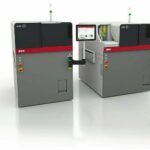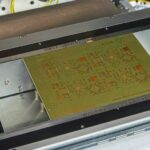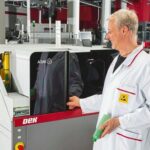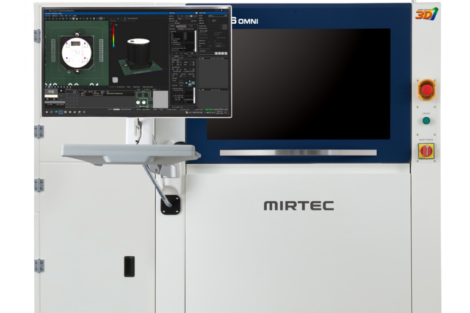With an alignment accuracy of ±12.5 microns @ 2 Cmk and a certified wet accuracy of ±17.0 microns @ 2 Cpk, the DEK TQ platform is one of the most precise paste printers on the market, enabling it to print pads for 0201 (metric) components and other modern ultra-fine-pitch applications. Featuring the same level of positioning accuracy and process stability as its forerunner, the new DEK TQ L delivers significantly enhanced performance within a footprint that is only slightly larger (1.3m x 1.5m rather than 1m x 1.3m). All DEK TQ printers can also be combined to operate in tandem by positioning two machines back-to-back: doubling the line’s printing capacity without increasing its length.
Versatile format
The biggest difference in the DEK TQ L compared to the earlier model is the significant increase in the size of the boards it is able to process. The new system is suitable for PCBs measuring up to 600mm x 510mm (approx. 23.6“ x 20“) – a 90 percent increase compared to the DEK TQ. At 560mm x 510mm (approx. 22“ x 20“), the DEK TQ L’s printable area has also grown by more than 78 percent. This generous production format offers electronics manufacturers new degrees of freedom. Not only can they print larger PCBs but, with the speedy three-stage conveyor, they can also process three substrates with a length of up to 345 millimetres in one pass.
Off-belt speed with linear drives
ASMPT has also employed linear motors throughout the DEK TQ L. This off-belt concept improves not only the machine’s precision and repeat accuracy, it also helps it deliver high processing speeds with a core cycle time of 6.5 seconds or less with the three-stage conveyor. The innovative clamping system, a more advanced printhead and the NuMotion controller with fiberoptic cabling (developed by ASMPT) further contribute to improvements in production speed.
The high-speed understencil cleaning system also operates with its own linear drives, which makes it twice as fast as conventional systems. Additionally, depending on the board size, the cleaning system can be equipped with three different sizes of fabric rolls that can be changed quickly and easily.
Zero-line-stop philosophy
The new platform‘s printers are designed to run for more than eight hours without user intervention. For normal cleaning cycles, a 22-meter fabric roll is long enough for a whole shift, and the seven-litre cleaning fluid tank requires a refill only after eight hours or longer. The cleaning agent is applied (from above via a dispenser) onto the board area being processed, significantly reducing consumption. The pivot design ensures coplanary contact with the stencil underside for maximum cleaning quality.
To minimize manual assists, an optional paste management system with automatic paste dispenser and integrated paste height control with individually-configurable warning and stop thresholds is available. Also available to facilitate non-stop printing is the optional Dual Access Cover, whose laterally movable portion provides full access to the paste cartridge so that it can be replaced while the main cover stays closed and the printer keeps operating.
Needs-oriented automation
The DEK TQ L printer has been designed to fit in with ASMPT’s Open Automation approach. This cost-optimized alternative to the fully-automated shop floor has proved successful in electronics production. By allowing users to automate existing lines and processes in stages according to their needs, the company offers a variety of solutions for step-by-step automation for the new platform (based on ROI considerations). As Jens Katschke, Senior Process Solutions Manager at ASMPT, explains, “the various automation options for the latest generation of DEK TQ printers enable SMT manufacturers to design an Integrated Smart Factory in accordance with their own ideas without having to depend on a specific equipment manufacturer.”
Customers who opt for the additional Smart Pin Placement feature can also benefit from fewer manual assists. The system operates with two pin sizes (4mm and 12mm in diameter). In the DEK TQ L, the magazine holds up to 60 pins and the system automatically verifies the position and the height of each pin after setting it. This prevents any single pin which is perhaps minimally elevated by dirt on the table from damaging the entire assembly.
Automation options for the Integrated Smart Factory go even further. Together with the WORKS Process Expert software, the Process Lens SPI system partners with the DEK TQ L to form a system that is as productive as it is functional. It provides the printer with continuous feedback about the print quality and can even modify settings on the system, allowing the printing process control and optimization functions to run autonomously. It can even take process data from third-party systems into account, for example from AOI systems at the end of the line. The understencil cleaning process can also be controlled automatically. It is no longer carried out based on a rigid schedule, but only when the intelligent quality management system recognizes, based on measurements data, that a cleaning cycle is needed.
Easy integration via open interfaces
Since open, non-proprietary and easily retrofittable systems are major advantages of the Open Automation concept, the new printer features multiple interfaces and protocols. Examples include the IPC-HERMES 9852 and IPC-CFX standards for process data and ASMPT workflow solutions such as the WORKS module Command Center, plant-wide asset and maintenance management with Factory Equipment Center, or the entire WORKS smart shop floor management suite. Third-party systems and IT systems such as MES or WMS solutions, extensive remote support solutions, and many more are also supported. With WORKS, for example, print jobs can be programmed entirely offline.
Reference class
The precise printing, high process stability, small footprint and flexible automation options of the new solder paste printing platform have raised the bar. Thanks to standardized, open interfaces, it is just as easy to integrate the new high-speed printer into an existing line as it is to combine it with machines from other manufacturers or to automate the production in stages. If you need to print large boards with precision or want to make your production more flexible, you should take a look at the DEK TQ L.












